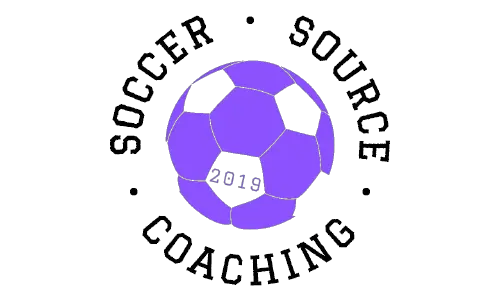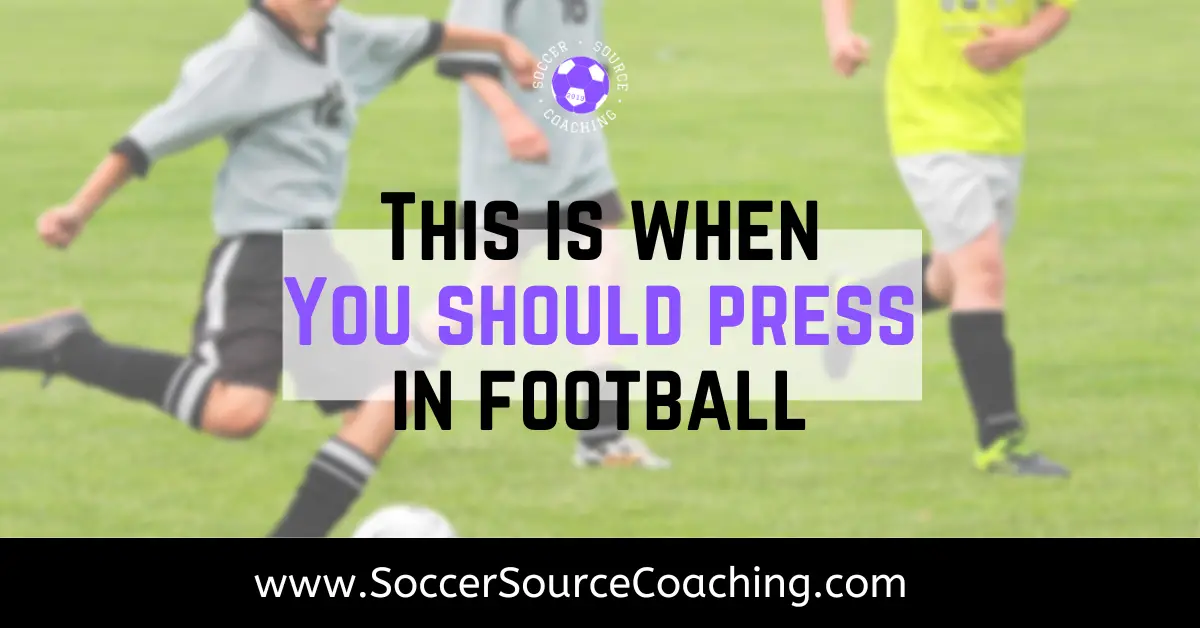To outsiders looking in, players pressing in football make seems incredibly simple. However, there are more things going on than what meets the eye. The players are looking for key pieces of information that tell them whether or not they should press.
These snippets of information are called pressing triggers, and these tell the players when they should press in football.
These are the pressing triggers you need to look out for so you know when you should press in football!
Depending on the type of press in football, the triggers might be different.
Triggers in football so you know when to press
To quickly summarise these are the 7 pressing triggers in football to help you decide whether you need to press or not:
- Poor Touch/control
- When a player is facing their own goal
- A player hesitates on the ball
- When the ball goes wide
- A player is using their weak foot
- Sloppy pass
- The Player hasn’t checked their shoulder/scanned the area
I go into more depth about each of these pressing triggers below.
When a player is pressing individually, they will likely be in a 1v1 scenario. These are some crucial 1v1 defending tips to help your players successfully defend while pressing.
Poor touch/control
This is one of the more obvious pressing triggers in football.
If a player takes a poor touch you should immediately press the player.
When an opposition player takes a bad touch they are already on the back foot and playing catch up to control the ball.
By pressing quickly you will either:
- Force them to kick the ball long or out of bounds
- Steal the ball in a dangerous area of the pitch
- Gain a free-kick if the opposition fouls you
The opposition player will then continue to play the rest of the game on edge knowing that the team will look to capitalize on their poor touches.
When a player is facing their own goal
This is a really effective pressing trigger that will help your team force back the opposition team.
When a player turns and faces their own goal it is because they usually do not have the option to play forward or sideways.
As a last resort, they have turned back to try and play a pass backward.
When a player turns and faces their own goal, under no circumstances should let them turn back around again!
This is how you should press them:
- Quickly close the gap between yourself and the opposition play
- Keep an arm’s length away and press in a side-on position (just in case they try to turn you)
- Make sure the opposition player can feel your arm on their back so they know you are pressuring
However, don’t get carried away and continue pressuring the next player they pass to.
Maintain your discipline and role in the press.
When a player hesitates on the ball
Confidence in your ability and your team’s ability plays a huge role in football.
Every player can’t play to 100% all the time.
This is why teams will tend to target players who are hesitant or not as confident as the ball.
Hesitancy will come in different forms, it could be:
- Taking too long to make a decision
- Rushing through a decision
- Taking too many touches on the ball
- Not looking to receive the ball
A lack of confidence may come from previous poor decisions such as:
- Taking a bad touch
- misplacing a pass
- Giving away possession cheaply
When you see any of these characteristics you should press the player.
You can even go one step further by forcing the opposition players to pass to the hesitant players on the team by adapting how you press.
When the ball goes to the player’s wide areas
This is a trigger to press is that players that receive the ball in wide areas have fewer options on the ball when compared to those that receive it in central areas.
It is also easier to show an opposition player towards the byline forcing the out of bounds by limiting their space.
If the wide player receives the ball and cannot go forward, their only other options are to either play sideways or backward.
This is why a pressing team will press a team to show them the wide areas of the pitch.
The player using their weak foot
Typically players will feel more comfortable on one foot than the other.
During gameplay, try to figure out which foot the opposition player prefers kicking with.
Once you have figured this out players will typically press from an angle that turns that player onto their weak foot.
This will make the opposition player:
- More predictable
- Hesitant (because they are not as comfortable on their weak foot)
- More likely to miscue a pass
When you see a player turn onto the weaker foot continue pressing them and allow them no wiggle room for them to get the ball back onto their stronger foot
Bad quality pass
While under pressure players on the ball may make a poor pass, either by under-hitting it or by putting their teammate in an awkward position.
Make sure you are able to apply pressure and press in either situation.
Using this as a trigger you may be able to gain possession of the ball in an advantageous position or put the opposition player receiving the ball in a tough spot.
Typically these passes are sideways passed as they are easier to intercept.
The player hasn’t scanned or checked their shoulder when receiving the ball
At the top level, players will be constantly scanning and checking the area to ensure they can make the best possible decision while they are on the ball.
Sometimes these players get caught sleeping and don’t do it!
The player who is most likely to fall victim to this press is a player who is looking to receive the ball on the half-turn between defensive lines.
As soon as you see a player receives the ball on the half turn without checking their shoulder, will have a very slim chance of knowing that you are behind them.
If you quickly press you can either regain possession of the ball for your team or force the opposition player back to their own goal.
Final thoughts on when to press
Pressing in football is a great way to regain possession of the ball in a dangerous area of the pitch for your team.
Especially if it is a high press.
These pressing triggers will give you a better idea of when you should or shouldn’t press in football.
Remember that pressing is very situational and each team will have a different way they would like to press.
Regardless of the pressing tactics, these are 6 skills you need to get better at pressing in football
For an effective press to work, all members of the team must be on the same page of thinking.
All it takes is one player not to press and the press will be easily broken.
These are the pressing soccer drills I like to use with my teams.
If you found this post on knowing when you should press in football helpful or know someone that would please share with them using our social media buttons.
Thank you for reading and sharing,
Toby
The best way to take your soccer improvement seriously
To see improvement in your overall soccer game you need to constantly push your boundaries.
A player’s work ethic is a strong reflection of how serious they are to get better, however, working hard in the wrong areas can be an individual’s biggest downfall.
Training harder and smarter to optimize your potential has never been easier with the latest advancements in technology.
SoccerBee GPS Wearable Tracker and Vest

The SoccerBee GPS Wearable Tracker and Vest brings cutting-edge technology used by the pros, to the fingertips of aspiring soccer players.
Features include:
- Distance ran
- Top Speed
- Average speed
- Number of sprints
- Heat map
The Fifa-approved technology will pinpoint areas of improvement for your game in competitive and casual matches.
As well as tracking your own stats, you can also compete with your teammates to push each other to be the best they can be
The SoccerBee Lite GPS Wearable Tracker is a cheaper option, however, this will only run the essential metrics.


1 thought on “When Should You Press In Football?| 7 Pressing Triggers”
Comments are closed.